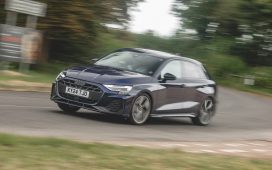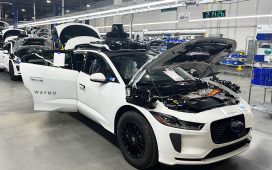Transportation leaders in Oregon and Washington have been planning to replace the I-5 bridge connecting Portland and Vancouver across the Columbia River for nearly 20 years. Planners say a new bridge is overdue, but the hurdles of two decades ago still exist.
The current I-5 bridge is old. The first section, which now serves northbound traffic, was built in 1917, and the southbound section was built in 1958. Among other problems, neither part is seismically resilient, and the bridge is very difficult to cross for anyone on foot or bicycle.
In an effort to reduce traffic congestion, planners also want to widen the freeway on the new bridge by adding auxiliary lanes and shoulders. Critics say any new lanes will induce traffic demand and drive up greenhouse gas emissions.
The Columbia River Crossing (CRC) project— the previous iteration of what is now the Interstate Bridge Replacement (IBR) program– was launched in 2005. The project was hit with public backlash and struggled to get required political support due to numerous concerns. Most concerns centered around plans to toll drivers, the impact of construction on residents of Hayden Island, problems with planned bridge clearance for ship passage, the proposed MAX light rail expansion, and the environmental effects of widening I-5. The CRC ultimately died in 2013 after years of turmoil.
Almost 20 years after the CRC’s launch, the IBR faces many, if not all, of those same challenges. But as the current I-5 bridge ages, and traffic congestion on the I-5 corridor grows more frustrating, project leaders face a more welcoming political landscape for the project.
Program critics fear desperation to get the project done will result in an expensive, hulking bridge over the Columbia River that doesn’t meet the needs of the moment, or the future. They say current bridge proposals hinder regional climate goals by catering too much to car traffic and failing to adequately plan for public transportation.
As bridge cost estimates continue to rise, the project is moving forward without much public awareness of what the IBR plans to build. Critics are worried project leaders never had a realistic budget for the bridge replacement, and are bound to keep asking state and federal agencies for more money without accountability.
Cost estimates have nearly doubled since 2020
In 2020, IBR program leaders estimated the project would cost between $3.2 billion and $4.8 billion. By December 2022, the IBR released a new project price projection, estimating the bridge would cost between $5 and $7.5 billion to build.
Earlier this month, while conducting a bridge tour with Washington’s US senators, IBR Program Director Greg Johnson revealed the project’s price tag may still be in flux. Johnson didn’t provide a new price estimate, but said the project is experiencing the effects of a “continuing creep of costs” in the construction industry.
An IBR program email to the Mercury said project leaders will complete another cost estimate this summer that “reflects current market conditions and accounts for potential risks and opportunities to the current cost estimate.”
“For a program of this size, it is anticipated that the cost estimate would continue to be refined as additional details are known,” project leaders stated. “At this time, we do not know if the program will exceed its current estimated cost range of $5 to $7.5 billion, with $6 billion as the most likely estimate.”
Joe Cortright, Portland economist and local transportation agency watchdog, predicts the project’s price tag will rise to about $9 billion— and it could even become more expensive.
“ODOT has a consistent track record of lowballing pre-construction cost estimates, and recording huge cost overruns, with the average price of a major project doubling between pre-construction estimates and final costs,” Cortright wrote in a January 4 City Observatory article. “It’s the old bait-and-switch: get the customer to commit to buying something with a falsely low price, and then raise the price later, when it’s too late to do anything about it.”
Cortright’s analysis says the IBR program is “exaggerating the importance of inflation” in the price increase and “downplaying its inability to accurately calculate future costs.” He also pointed out that Oregon and Washington’s transportation departments haven’t fully identified how they’ll fund a $7.5 billion bridge, let alone a more expensive project.
Tolling drivers using the bridge is one likely source of revenue, though it’s unclear what the toll rate would be or how amenable people would be to paying it. According to the IBR program website, “tolls will be used for construction, maintenance, and operation of the facility, and to help improve travel reliability within the bridge corridor.” Transportation commissions in Oregon and Washington would be responsible for deciding rates and discounts.
Tolling proposals haven’t been received well in the Portland metro area in the past. The backlash to an Oregon Department of Transportation (ODOT) plan to toll segments of I-205 in Clackamas County prompted Governor Tina Kotek to order a pause on toll collection efforts until 2026. The governor’s move limits what the IBR program can do to raise money via tolling in the near future.
Project leaders are also heavily relying on federal grants to pay for the project. In December, the IBR program secured a $600 million US Department of Transportation grant: The first federal contribution to the project. Oregon and Washington have both pledged $1 billion contributions. State legislators in Oregon moved to give the significant funding to the IBR program last June, setting aside $250 million of general obligation bonds each biennium until 2029. Critics said the decision came at the eleventh hour of the 2023 legislative session, and raised concerns about promising so much funding without putting adequate safeguards on the IBR program’s spending.
State Rep. Khanh Pham (D-Portland), a member of the Joint Committee on Transportation who has advocated for more fiscal guardrails for the IBR program, wrote in a social media post that she is “concerned that spiraling costs for the [IBR] could jeopardize our ability to invest in other state priorities, like education and housing.” Pham pledged to continue advocating for “a right-sized bridge replacement in line with our state’s values.”
Any financial support for the project that doesn’t come from the federal government will ultimately be placed on local taxpayers.
“Oregon and Washington taxpayers will be on the hook for these amounts,” Cortright, the economist, wrote. “Every cost increase raises the amount they have to contribute.”
Prioritizing public transit
For public transportation users in Vancouver and Portland, the most exciting aspect of the IBR program is its transit component. The project is federally required to include a mass transit option, and the preferred design plans outline a MAX light rail extension into Vancouver. Project leaders also reiterate the new bridge will have improved bicycle and pedestrian facilities, making it safer and more pleasant to ride across the Columbia River.
Encouraging people to shift away from personal vehicle use and toward walking, biking, and taking public transit will be crucial for Oregon to reduce greenhouse gas emissions and meet state climate goals.
But program critics say the bridge, as expensive as it may be, may not prioritize public transit the way project leaders claim it will.
In their plans for the MAX light rail extension, IBR program leaders have indicated the train will travel across the bridge on direct fixation rails. Direct fixation rails are raised on blocks above the surface of a roadway, making it so non-rail vehicles can’t utilize the same road space. In comparison, the Broadway, Steel, and Tilikum Crossing bridges in Portland all have embedded railways, allowing for increased transit capacity on the same roadway.

Direct fixation rails preclude bus transit from using the transit right-of-way, which public transportation advocates say would allow for more efficient movement. If MAX trains run every 12 to 15 minutes across the I-5 bridge, there’s plenty of time in between for buses to use the same roadway.
In a conversation with the Mercury in August, IBR program Director Greg Johnson said project leaders favor direct fixation rail tracks because of price concerns. However, he also said the plan could change with further conversations.
Planners propose buses traveling between Portland and Vancouver use “safety shoulders” along the bridge in lieu of dedicated bus lanes. But those auxiliary lanes are likely to be blocked by stalled motorists, relied on by emergency vehicles, and won’t give buses a dedicated access lane.
The current I-5 bridge has three travel lanes in either direction, which IBR planners say is insufficient for traveler safety. Project planners say having a bigger shoulder for vehicles that need to pull off the road will reduce congestion, especially after crashes.
According to Cortright and other freeway expansion skeptics, however, shoulders and “auxiliary lanes”— another key element of the IBR which will result in a wider bridge— are just excuses for highway widening. Cortright said there’s no guarantee Oregon and Washington’s transportation departments won’t decide, at some point, the number of travel lanes on the I-5 bridge are insufficient. In that case, they could decide to restripe the shoulder and allow through passenger vehicles to use it as an additional lane.
“Saying they’ll run the bus on the shoulder gives the IBR an excuse to have very wide shoulders on the bridge and make the bridge wider,” Cortright said. “It’s an incredibly short-sighted decision that forecloses transit opportunities.”
Transparency concerns
Last spring, IBR leaders released computer renderings showing several potential bridge designs– the most significant mockup images that have been released so far. But the renderings don’t depict the bridges’ planned height and width, and are only shown from a distant vantage point.
To Cortright, this is an example of the IBR team’s continued opacity about their plans.
“They’ve been very careful at every step in the process to just show us pictures of the ugly old bridge and show us almost nothing of the proposed new bridge,” Cortright told the Mercury. “The pictures they do show demonstrate what it would look like from probably a couple of miles away, which make it look very small. And they don’t show what it would look like on the Vancouver waterfront, or on Hayden Island. That’s a very conscious decision on their part.”
In November, Cortright delivered a letter to the Federal Highway Administration and US DOT on behalf of the organization No More Freeways, asking the federal agencies to “take no further action to advance the proposed Interstate Bridge Project until it has made the necessary determination… that funding for the project is effective.” The letter states the IBR program’s own benefit-cost study is “riddled with errors and unsubstantiated claims,” and the project, in its current form, is a major misuse of public funds.
But the program has secured $2.6 billion in state and federal funds, and while the project has some vocal critics, including one in the Oregon legislature, it’s mostly operating without much oversight.
The IBR’s Modified Locally Preferred Alternative (the plan that determines the project’s crucial components that will go forward through an environmental review process) and program components are in the process of environmental evaluation. This spring, the IBR program plans to release a Draft Supplemental Environmental Impact Statement using the environmental evaluation findings, which will be open for public review.









